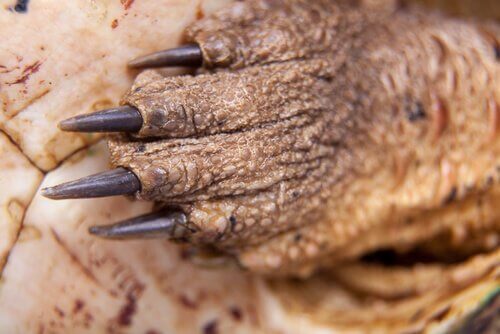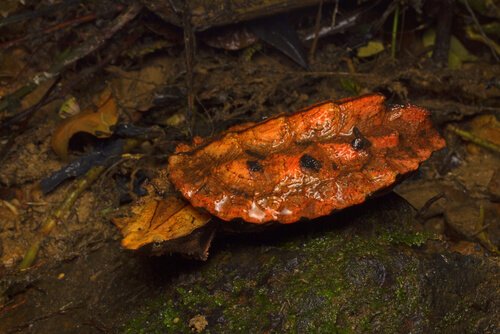Characteristics and Distribution of the Matamata Turtle


Written and verified by the lawyer Francisco María García
The Matamata turtle is a unique and unmistakable animal of its kind, because of its peculiar appearance. It’s different from most turtles, which can look cute and innocent. This species can frighten people who aren’t aware of what it is.
Next, we’ll tell you more about the unusual matamata turtle: its physical characteristics, behavior, habitat, and reproduction.
Physical characteristics and taxonomy of the matamata turtle
Morphologically, the matamata is characterized by having a large, elongated, flattened and triangular-shaped head. Its neck is also flat and long, and it’s longer than its spine, which is protected by its shell. The sides of its neck have some spikes that make it look like a saw.
Its skin is covered with bumps or tubers, which make it look unattractive. You can also see a pair of whiskers and two additional filaments on its chin.
Nevertheless, these so-called “skin scales” are very important to this reptile’s everyday life. Because it looks so strange, the matamata turtle manages to camouflage easily with its surroundings. It can go completely unnoticed by possible predators.
The snout of the matamata turtle is also very striking, because of its tubular, elongated form. It looks similar to a horn. Its nose acts like a snorkel, allowing it to remain underwater for several hours without having to come up for air.
The shell of the matamata measures approximately 17 inches long in adult males. Its predominant color may vary between dark brown and black. Its plastron is narrow, notably tilted backward, and short in the front.

Sexual dimorphism
The main sexual dimorphism of matamata turtles is the shape of their plastron. The plastron of males is notably more concave than in females. In addition, its tail is longer and thicker.
Matamata habitat
The matamata turtle is a species of freshwater turtle native to South America. It populates the Amazon and Orinoco river basins extensively. In addition, its range extends through Brazil, Columbia, Peru, Venezuela, Ecuador, and Guyana.
The matamata shows a notable preference for the calm waters of rivers, ponds, and marshes, as well as sewage streams. It usually lives in shallow areas, since its snout must be able to reach the surface to breathe.
Interestingly, the matamata has been artificially introduced to some drainage channels in southeastern Florida (USA). This probably happened as a result of the illegal exotic pet trade. However, to this day, the population of matamatas in that area is unknown.
Diet of the matamata turtle
These turtles are strictly carnivorous. Their diet is based mostly on the consumption of cichlid fish and aquatic invertebrates. Their hunting technique is intelligent and opportunistic: they take advantage of their ability to mimic their environment in order to hunt.
The matamata spends many hours practically motionless underwater, with its neck raised, and camouflaged with its surroundings. When it identifies its prey, it pushes its head out and opens its mouth as wide as possible.

This movement generates a low pressure “microenvironment” that sucks the prey into the turtle’s mouth. Then, the turtle quickly closes its mouth, swallows its prey, and expels the water slowly.
Reproduction of the matamata turtle
The breeding season of the matamata occurs once a year, with the advent of spring in the southern hemisphere. Males and females come together to mate from the beginning of October to mid-December.
Before mating, the male tends to extend its head repeatedly, opening and closing its mouth at the same time. It may also extend its limbs and toss its head toward the female to catch her attention.
After mating, the female remains pregnant for about 200 days. At the end of gestation, she lays between 12 and 20 spherical eggs. They are very brittle, and must be deposited carefully.
The offspring are small, and their plastron and the lower edge of their shells have a pink or slightly reddish color. Their hearing and sense of tact are very well developed, but they tend to have poor vision. They have sensory nerves in the folds of their skin that help them detect movements in their surroundings.
In captivity, the matamata turtle can live for about 35 years. However, its natural life expectancy in its natural habitat is still unknown. Scientists estimate it lives for 15 to 20 years.
This text is provided for informational purposes only and does not replace consultation with a professional. If in doubt, consult your specialist.